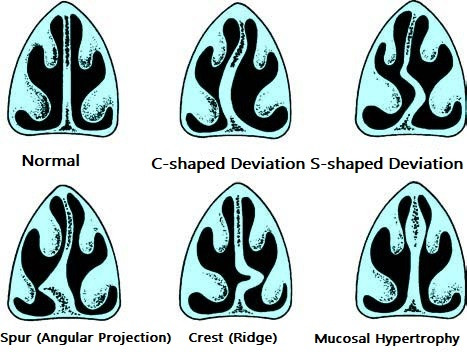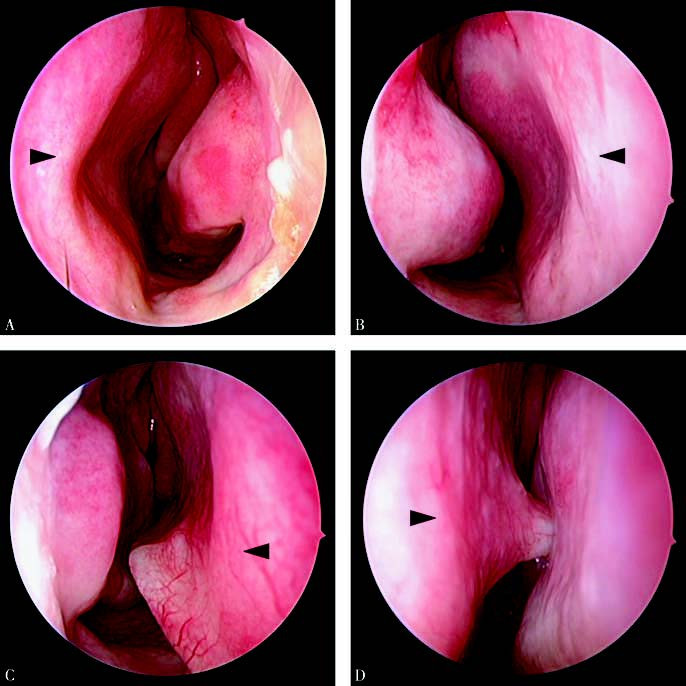Nasal septum deviation refers to the displacement of the nasal septum to one or both sides, or the presence of localized protrusions, leading to clinical symptoms such as nasal obstruction, headache, and epistaxis. The clinical types of nasal septum deviation include C-shaped, S-shaped, spurs (sharp cone-like projections), and crests (ridge-like projections extending from anterior to posterior). The nasal septum is composed of multiple cartilage and bony structures that form complex interconnections. Balanced growth and development of these bones are essential for maintaining the nasal septum in a central position. Any abnormal development of one bone can affect the growth of others, resulting in various forms of abnormal connections. Therefore, the clinical presentations of nasal septum deviation are diverse.

Figure 1 Schematic diagram of nasal septum deviation

Figure 2 Nasal septum deviation (endoscopic view, arrows indicating the nasal septum)
A. C-shaped Nasal Septum Deviation
B. S-shaped Nasal Septum Deviation
C. Nasal Septum Crest
D. Nasal Septum Spur
Etiology
The primary cause is the uneven growth of the bones constituting the nasal septum, forming abnormal tension curves and leading to irregular connections between bones. In childhood, factors such as adenoid hypertrophy and a high arched palate may limit the development of the nasal septum and cause deviation. Nasal trauma may result in nasal septum fractures or dislocations, contributing to deviation. Space-occupying lesions in the nasal cavity can also cause deviation due to the gradual enlargement of the lesion, which compresses the nasal septum.
Clinical Manifestations
Nasal Obstruction
This can manifest as unilateral or bilateral nasal obstruction. In cases of alternating nasal obstruction, the affected side tends to be more severe. Severe cases can present with persistent nasal obstruction on the deviated side. The degree and nature of nasal obstruction are related to the type of deviation and whether compensatory hypertrophy of the inferior turbinate is present.
Epistaxis
Bleeding often occurs on the convex surface of the deviation, or at the tips of bony spurs or crests. The mucosa in these areas is thin and prone to erosion and bleeding due to irritation from airflow and dust.
Headache
Reflexive headache on the affected side may occur when the deviated protrusion compresses the ipsilateral nasal turbinate.
Symptoms of Adjacent Organs
Obstruction caused by deviation can impair sinus drainage, leading to secondary sinusitis. Persistent open-mouth breathing due to impaired nasal ventilation can increase the risk of upper respiratory tract infections.
The severity of these symptoms is closely associated with the type and extent of deviation.
Diagnosis
Complete symmetry of the nasal septum is rare; most individuals have some degree of nasal septum deviation without significant clinical symptoms, which is referred to as physiological nasal septum deviation. Such cases, when identified during clinical examination, typically require no intervention. A diagnosis of pathological nasal septum deviation is made only when clinical symptoms are present and nasal septum deviation is confirmed through examination. Evaluation should consider the location, type, and relationship of the deviation with adjacent structures while ruling out other conditions, such as mucosal hypertrophy of the nasal septum (determined by probing for soft, elevated areas), as well as other pathologies that may cause deviation.
Treatment
Surgical correction is required for symptomatic nasal septum deviation.
Common surgical procedures include submucous correction of the nasal septum and submucous resection of the nasal septum. Submucous correction is more consistent with preserving nasal physiological function, as it involves the removal of only a small portion of the deviated cartilage and bone. This procedure is also suitable for adolescents with severe nasal septum deviation.